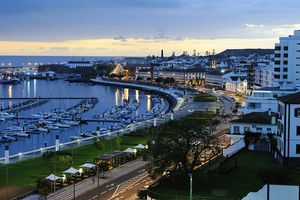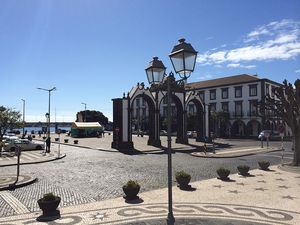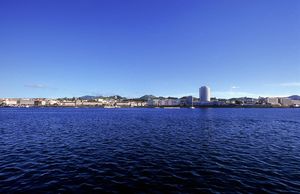
Ponta Delgada, Azores
Discover Ponta Delgada, the capital of São Miguel Island, Azores, Portugal
Ponta Delgada is the capital of São Miguel Island, and at the same time the main urban centre of the Azores Archipelago. This city gathers most of the services and bureaucracy of the archipelago. it acquired the rank of city after getting a Customs in 1546, but its glory was developed in the 17th and 18th centuries, extending to the 19th century with the orange exportation.
Its streets are paved with black basaltic stone and white limestone, making geometric or marine compositions; all of those in the old town exhibit plaques with its former name in blue, and the new one in white.
Beside the port you will find a promenade of 2 kilometres, amused with terraces on the summer time. Among the must visit places you will see the Igreja Matriz de São Sebastião Mother Church, the Camarín del Santísimo Cristo Niche (hosted in the Esperança Convent), the Carlos Machado Museum, and the botanic parks.
The urban heart of the city is located in the Praça de Gonçalo Velho Cabral Square, with the discoverer’s statue dating from 1953, and buildings with arcades and plain facades to highlight the Portas da Cidade Doors, dating from 1783. Behind them is located the tower of the mother church, to which, in the 19th century, was added an upper floor with the clock.
In front of the church you will find a little square, dominated by a beautiful fountain, the Saint Michael Archangel, dating from 1955, patron of the island, and by the facade of the Consistory, dating from the 17th and 18th centuries, which counts with an adjoining tower in 1724.
The Igreja Matriz de São Sebastião Mother Church is very interesting for its architecture as for its inside, where it hosts a little museum. To the West, closer from it, is located the praça Vasco da Gama Square, decorated with a cast iron fountain which is decorated by four Tritons put over some turtles, and an allegorical figure of Joy.
Closer to here raises the São Brás Fort, a Renaissance fort built up in 1552 to defend the city. In front of it there is a lively square named 5th of October, but is better known as Campo São Francisco; on it are stands during the festivities of the Santísimo Cristo, with its biggest day on the fifth Sunday after Easter.
On its centre, there is a music stand with a water lily chanel where it raises the Esperança Convent, dating from 1541, which is characterized by its huge square tower, which is a compulsory visit.
In other of the Campo de São Francisco’s front, is placed the elegant Igreja de São José Church, which actually is the Franciscan of Nossa Senhora da Conceição, dating from the 16th century.
The Infante Dom Henrique Avenue, better known as Marginal, has a promenade which is very amused in the summer with terraces. From the port of Ponta Delgada set sail in 1832, the liberal fleet which after landing next to Oporto, achieved to proclaim the constitutional king Dom Pedro, overthrowing Dom Miguel’s absolutism.
A walk by the Marginal will lead you to the Igreja de São Pedro Church, a Gothic temple preceded by a stairway, and surrounded by an atrium-overlook.
Regarding the Carlos Machado Museum, it is hosted in the Santo André Convent. From its outside stands out the overlook tower and the decorated windows which light up the higher chorus; but its inside is even more fascinating.
Very close from the museum, following the rua de São João Street, towards the East, are located the Micaelense Theatre and the market, where you can buy products of the island.
In the lower street is located the municipal auditorium, which occupies the Igreja da Graça Church, since the 17th century, preceded by the bust of Luís de Camões and a stairway.
From the museum, if you keep going towards the West by the rua Dr. G.P.: Falcão Street, you will soon find, after having different perspectives of the mother tower, with the beautiful park with honour the memory of the poet Antero de Quental, with its bust placed above two feeling and reason allegories. This poet committed suicide in a public band nearby the Esperança Convent in 1842, and that is why today he is marked with an anchor.
In one of the sides of the park stands the Igreja de Todos-os-Santos Church for its Baroque palace unfinished facade.
Other pedestrian wooded squares, nice for walking and resting, are the Largo dos Mártires de la Pátria Square, with its araucarias and palm trees and a charming colonial environment with the Culture Municipal Centre, the Igreja da Conceição Church, with the adjoined Conceição Palace; and the Escola Antero de Quental School, hosted in a former 1839 palace; the Praça 2 de Março Square, with cactus of P.José Joaquim de Sena Freitas.
A bit Northern you will find, from East to West the Ermida de São Gonçalo Hermitage, and two big botanic parks: the José do Canto Garden, payment visit, counts with more than 3000 different species of exotic plants; and the António Borges Garden, better taken care of the previous one and free admission.
1 kilometres North from the city is located the city of Fajã de Baixo, very frequented by tourists. It is worth visiting the Igreja da Senhora dos Anjos Church, dating from the end of the 18th century.
2 kilometres from the previous city you will find Fajã de Cima, with the Igreja de Nossa Senhora da Oliveira Church, a Neogothic temple of the 19th century, and the amusement reservation of Pinhal da Paz, a 49 hectares space full of pine trees, azaleas, palm trees, acacias, and paths.
Nightlife:
The nightlife in Ponta Delgada focuses on the old town, where you will find most of the nightclubs and discos; the Campo de São Francisco, with stands during the festivities of Santo Cristo and during summer, where in the first hour is custom to drink a Caipirinha; and Marginal, with its promenade is the ideal place to drink a coffee in a terrace beside the sea.
Mapa Interactivo:
São Miguel Island
What to see:
- Ponta Delgada
- Jardim José do Canto Garden
- Igreja de São Roque (Mother Church)
- Sete Cidades
- Miradouro do Vista do Rei Overlook
- Miradouro da Ponta do Sossego Lookout
- Miradouro Pico do Ferro Lookout
- Ribeira Grande
- Miradouro de Santa Iria Lookout
- Lagoa do Fogo
- Caldeira Velha
- Paços do Concelho (Ribeira Grande)
- Nordeste
- Mosteiros
- Vila Franca do Campo
- Ilhéu da Vila Franca do Campo
- Praia Agua d’Alto Beach
- Furnas
- Lagoa das Furnas
- Capelas
- Terra Nostra Botanical Garden
Why "Portugal Travel"?
Portugal Travel is an organization of Portuguese agencies whose objectives are:
- ✓ To make Portugal, its culture and its heritage known.
- ✓ To promote sustainable tourism.
In collaboration with:
Escola Superior de Hotelaria e Turismo do Estoril
Turismo de Portugal
Copyright PortugalTravel.org © - All rights reserved.






